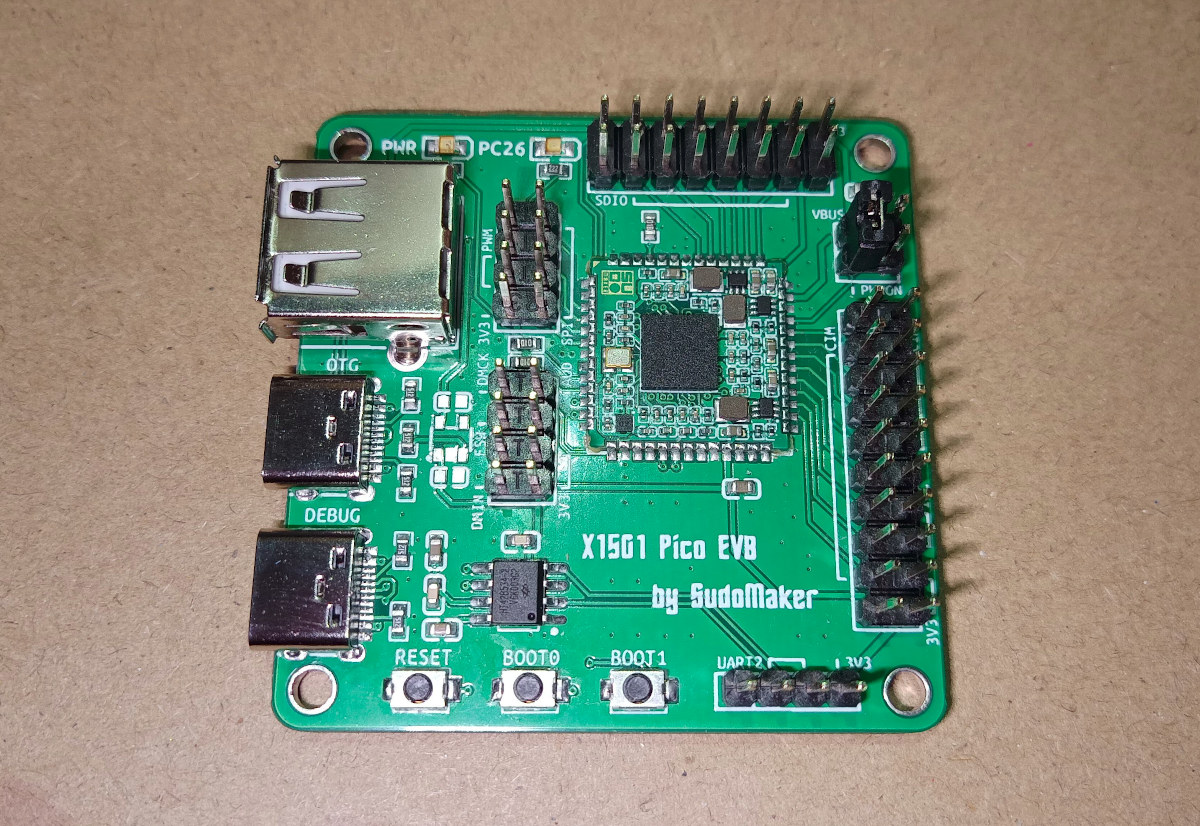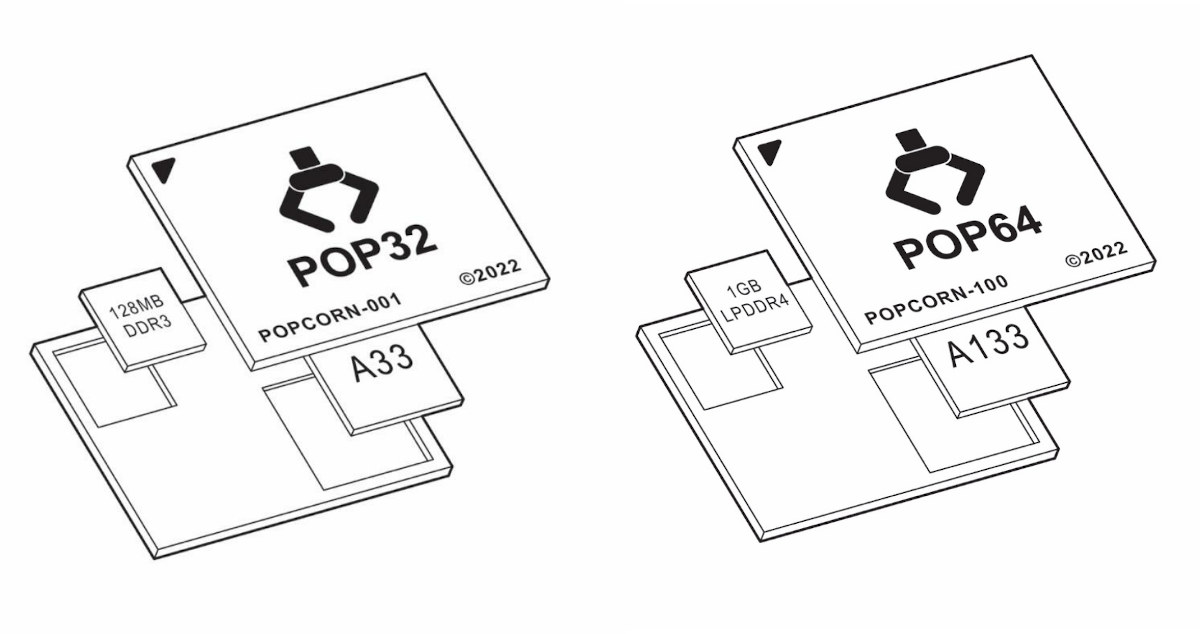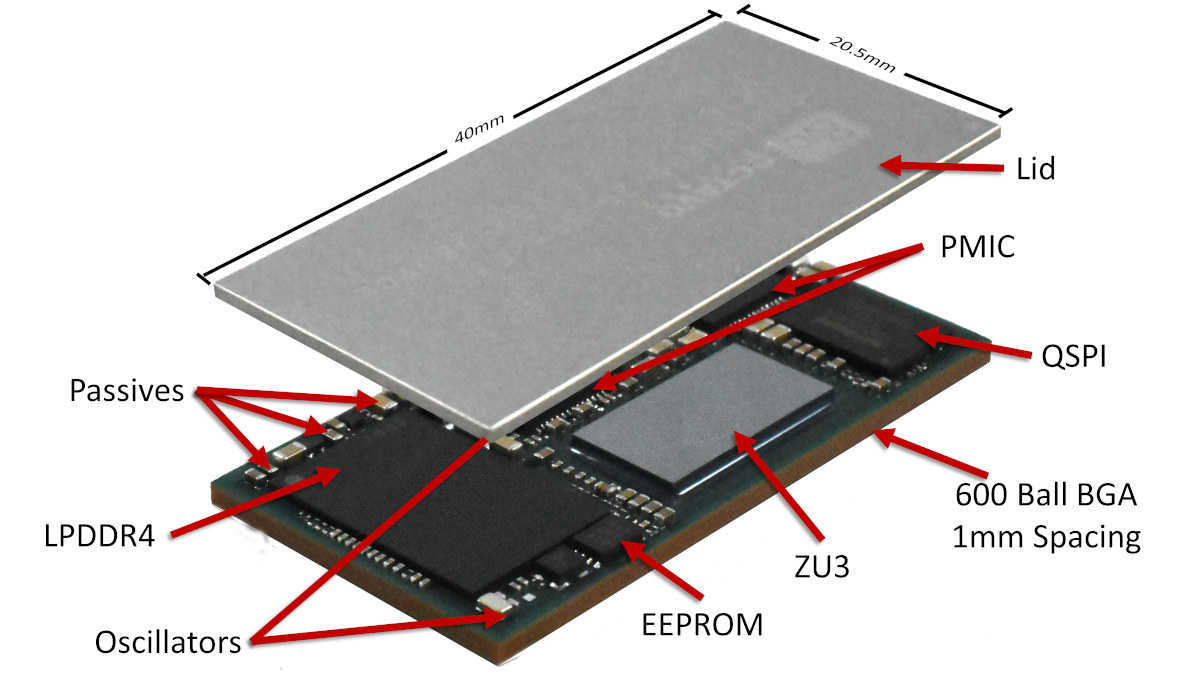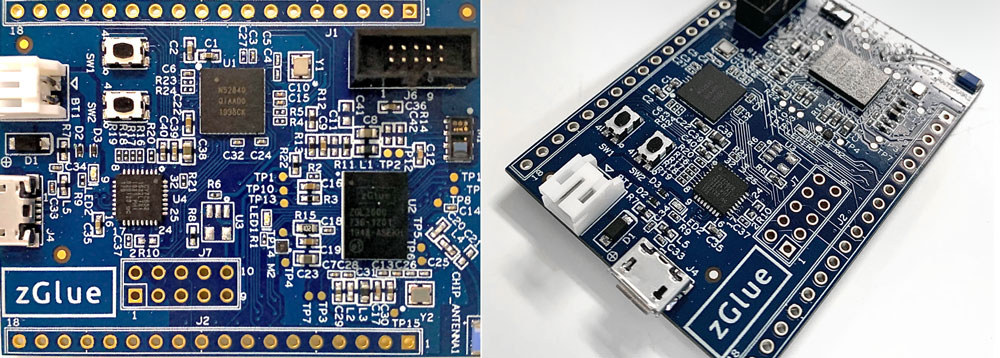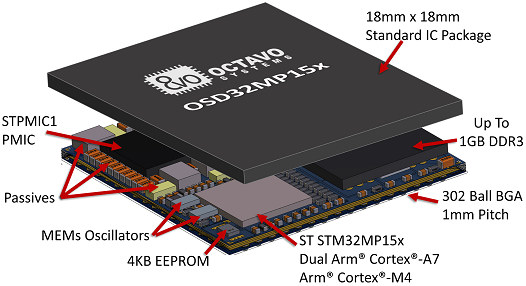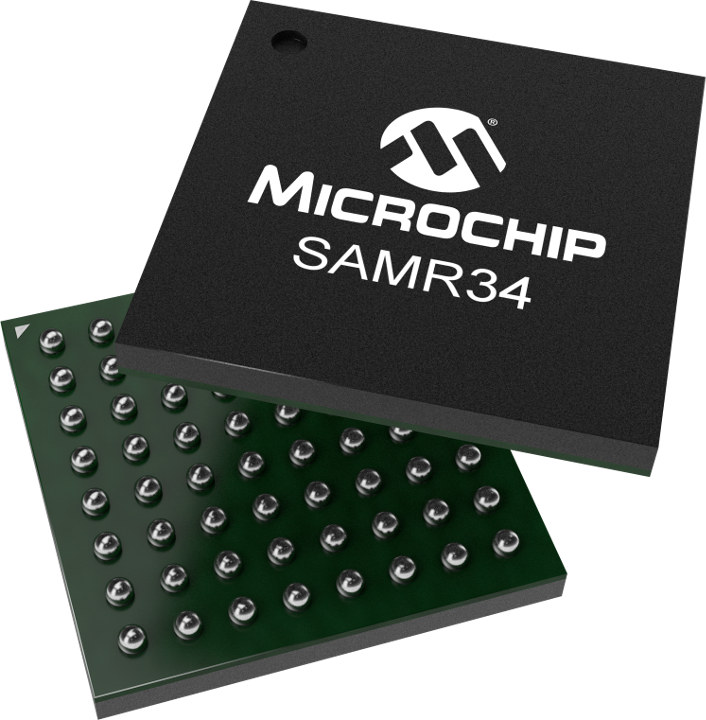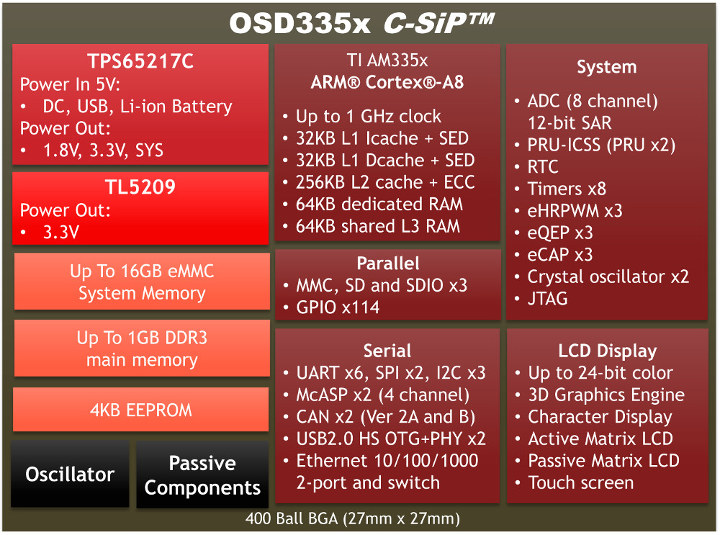We’ve just written about the Notkia phone repurposing Nokia 168x phones with a new PCB featuring an Ingenic X1000E MIPS processor running mainline Linux, but it turns out the developer (Reimu NotMoe, CTO of SudoMaker) has also designed the X1501 Pico SoM, a tiny 16×16 system-on-module equipped with Ingenic X1501 MIPS system-in-package (SiP). The module can be that small because the single-core 1GHz Ingenic 1501 SiP embeds 8MB LPDDR, as well as apparently a 16Mbit NOR flash that stores stripped-down versions of U-boot and the Linux kernel, plus a minimal, busybox-based rootfs. X1501 Pico system-on-module specifications: SoC – Ingenic X1501 MIPS32r2 processor @ 1GHz, a MIPSr2 real-time core @ 300 MHz (not shown in datasheet), 8MB LPDDR and 16KB tightly coupled SRAM, 16Mbit NOR flash Castellated holes with USB 2.0 OTG, I2C, SPI, SDIO and DVP, analog mono audio output & digital microphone input EFUSE based Secure Boot Power Management […]
POP32 & POP64 SIPs combine Allwinner A33 and A133 with SDRAM into a single package
Kettlepop is a board based on Allwinner GR8 system-in-package (SiP) with an Allwinner R8/A13 Arm Cortex-A8 CPU and 256MB RAM, and itself a derivative of the CHIP Pro board from Next Thing Co that closed doors a few years ago. Source Parts has just posted an update explaining that the GR8 SiP is not available anymore, so they worked on their own SiPs: POP32 and POP64. POP32 combines an Allwinner A33 quad-core Cortex-A7 processor with 128MB DDR4, while POP64 features an Allwinner A133 quad-core Cortex-A53 processor with 1GB LPDDR4. POP32 system-in-package POP32 highlights: SoC – Allwinner A33 quad-core Arm Cortex-A7 processor with Arm Mali-400 MP2, 1080p60 H.264, VP8, MPEG 1/2/4, JPEG/MJPEG video decoding, 1080p60 H.264 video encoding Memory – Built-in 128MB DDR3 Peripherals from SoC Storage I/F – NAND flash, 3x SD/MMC Display – MIPI DSI, LVDS, RGB LCD up to 1280×800 resolution Camera I/F – Parallel camera interface up […]
OSZU3 System-in-Package (SiP) combines AMD Xilinx Zynq UltraScale+ MPSoC with 2GB RAM, PMIC, passive components
Octavo Systems has collaborated with AMD Xilinx for the OSZU3 system-in-package (SiP) that combines Zynq UltraScale+ MPSoC ZU3 with up to 2GB RAM, power management circuitry, and other components into a compact (40×20.5mm) 600-ball BGA package. We’ve already written about other Octavo Systems SiPs in the past with solutions like OSD3358x (TI Sitara AM3358) and OSD32MP15x (STMicro STM32MP1), but the OSZU3 packs a much more powerful and flexible chip with the AMD Xilinx Zynq UltraScale+ MPSoC offering both Cortex-A53 & Cortex-R5F cores, Arm Mali-400 GPU, and FPGA fabric. Octavo Systems OSZU3 SiP specifications: SoC – AMD Xilinx Zynq UltraScale+ MPSoC ZU3 with CPU – 4x Arm Cortex-A53 up to 1.2GHz, 2x Arm Cortex-R5F up to 500MHz GPU – Arm Mali-400 FPGA 154K System Logic Cells 141K Flip-Flops 71K CLB LUTs 360 DSP Slices 7.6 Mb Block RAM System Memory – 2GB LPDDR4 Storage – 128MB SQPI, and 4K EEPROM (by […]
Omnichip Devkit 2 Features Nordic nRF52832 based zGlue ZiP Multichip Module
We first covered zGlue Integration Platform (ZiP) in 2018 when the company introduced its chip-stacking technology with a fitness tracker based on ZGZL1BA ZiP equipped with chips from Dialog Semiconductor, Analog Devices, Macronix, MCube and others. The concept is similar to SiP (System-in-Package), but zGlue claims the costs and lead times are much lower with the technology. Earlier this year, ZiP was back in the news thanks to Antmicro GEM custom RISC-V/Arm ASIC, and today, I was informed about zGlue Omnichip devkit 2 that is equipped with a ZiP of the same name, and that can be used to evaluate the technology. zGlue OmniChip ZiP zGlue OmniChip ZiP is a multichip module with the following ICs (aka Chiplets) and specifications: Nordic Semiconductor nRF52832 Cortex-M4F microcontroller with Bluetooth LE and NFC connectivity Texas Instruments BQ25120AYFPR battery charger, buck regulator Maxim Integrated MAX86140ENP+ optical pulse oximeter Texas Instruments TMP108AIYFFR temperature sensor Bosch […]
Octavo Systems Unveils OSD32MP15x STM32MP1 SiP (System-in-Package)
STMicro STM32MP1 is one of the most interesting microprocessor recently announced, as it should allow a relatively easy upgrade path for projects based on the traditional STM32 Cortex-M4 microcontrollers, thanks to backward compatibility, and the extra one or two Arm Cortex-A7 cores enabling Linux support. We’ve already seen several upcoming evaluation and development boards based on STM32MP157 processor including STMicro’s own discovery kits and evaluation platform, as well as Arrow Electronics Avenger96 board fitted with a tiny 29x29mm SoM. But I suspect we could see even more compact designs soon, as Octavo Systems has now unveiled OSD32MP15x system-in-package with STM32MP15x MPU, up to 1GB RAM, 4K EEPROM, STPMIC1 power management IC, two oscillators, and over 100 passive components all brought together into a 18x18mm package. Octavo Systems OSD32MP15x system-in-package main components and specifications: MPU (MicroProcessor Unit) – STMicroelectronics STM32MP15x with Dual Arm Cortex-A7 @ 650MHz, Arm Cortex-M4 real-time core @ […]
Microchip Releases Tiny SAM R34/R35 LoRa SiPs and Development Kit
Microchip has been offering RN2483 & RN2903 LoRa modules for respectively 868 MHz and 915 MHz frequencies for several years, but the company has now announced SAM R34 and SAM R35 LoRa systems-in-package (SiP) that offer similar functionality in a much smaller form factor. Both SiPs integrate a Microchip SAM L21 Arm Cortex-M0+ based MCU,a sub-GHz RF LoRa transceiver operating from 862 to 1020 MHz, and a software stack. That means you don’t need different SiP depending on the region, and the only difference between SAM R34 and SAM R35 is the latter does without a USB interface for lower cost. Microchip SAM R34/R35 key features and specifications: MCU – Arm Cortex M0+ MCU @ 48 MHz System Memory – Up to 40 KB RAM including 8KB LP-RAM Storage – Up to 256 KB Flash for application code and stack Wireless Connectivity 862 MHz to 1020 MHz coverage Up to 20 […]
Octavo Systems Adds eMMC flash and Oscillator to its TI Sitara AM335x SiP
Octavo Systems unveiled their OSD3358 System-in-Package (SiP) in 2016 with the package integrating TI Sitara AM3358 Arm Cortex-A8 SoC, 256 to 512MB memory, PMIC, LDO and passive components into a single package. The SiP is notably found in the $25 PocketBeagle board, which only adds a micro SD card slot, a micro USB port, and a few passive components to the PCB. The company has now gone further by also adding an eMMC flash and an oscillator to their OSD335x C-SiP. That means another version of PocketBeagle could potentially be made without the micro SD card, using the eMMC flash in the SiP instead, and adding an oscillator – missing in PoketBeagleBone – necessary to use low power modes and RTC wake-up. OSD335x C-SiP main specifications: SoC – Texas Instruments Sitara AM335x Arm Cortex-A8 processor @ up to 1 GHz with PowerVR SGX530 GPU, PRU Subsystem System Memory – Up […]
ZiP (zGlue Integration Platform) Enables the Design & Manufacturing of Low Cost Custom Chips
When I first started to read about zOrigin on Crowdsupply, I was not really impressed. Meh… Yet another Bluetooth LE fitness tracker with a few sensors, and an Android app. But as I read further, I found out the interesting part was inside the device: ZGLZ1BA, a custom chip manufactured using ZiP (zGlue Integration Platform) chip-stacking technology, which produces something similar to SiP (System-in-Package) but at a much lower cost and manufacturing lead time. But let’s have a look at zOrigin tracker first, which acts as a demonstration / evaluation platform for ZiP technology. Key specifications & features: “SoC” – ZGZL1BA ZiP with Dialog Semiconductor DA14585 16MHz 32-bit ARM Cortex M0 MCU with BLE Analog Devices AD8233 Heart Rate Analog Front End (AFE) Macronix MX25R4035F 2 Mbit Flash Memory MCube MC3672 Accelerometer Maxim MAX77734 Power Managment IC (PMIC) SiTime SIT1552 32 kHz Oscillator Vishay SI8466EDB MOSFET 30 passive components Package […]


